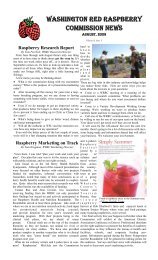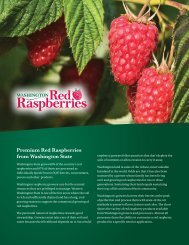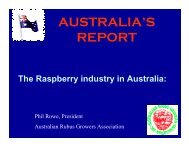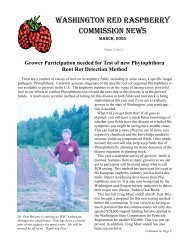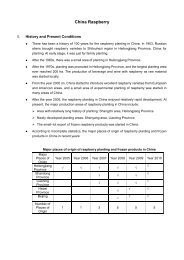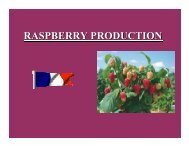2012 - Washington Red Raspberry Commission
2012 - Washington Red Raspberry Commission
2012 - Washington Red Raspberry Commission
You also want an ePaper? Increase the reach of your titles
YUMPU automatically turns print PDFs into web optimized ePapers that Google loves.
We will collect large quantities of P. penetrans and clean the nematodes from contaminating<br />
plant material and other nematode species. Root-lesion nematodes will be stored in an ultra-low<br />
freezer at -80 ºC. Once a sufficient amount of nematode material has been obtained, we will<br />
isolate mRNA, which represents the message of genes. To create a collection of all P. penetrans<br />
genes, we will sequence all genes using high-throughput sequencing technologies. Once<br />
sequence data has been obtained, we will process it to remove contaminating sequences from<br />
plants and other organisms. The more active a given gene is, the more sequences we will obtain<br />
for that particular gene. We will sort all sequence data and generate a profile for all genes that<br />
will show us a range from the most to the least active nematode genes.<br />
2) Identify P. penetrans secretion genes and effector gene candidates.<br />
To separate P. penetrans genes that produce secretions from other genes, we will search for<br />
genes that contain a signal peptide-coding region using SignalP software (Bendtsen et al. 2004).<br />
The signal peptide region is a hallmark of genes that produce secretions and is therefore present<br />
in all effector genes. Once we have narrowed down the total gene library to those genes that<br />
produce secretions, we will screen for the most active effector genes. To this end, we will use a<br />
technique, in situ hybridization, which employs a color reaction specific to individual gene<br />
sequences in question. By using a microscope, we will be able to determine whether the<br />
produced pigment is present in P. penetrans salivary gland cells. This would indicate that the<br />
respective gene is active at that location and therefore a potential effector gene (de Boer et al.<br />
1998). We will focus on those effector gene candidates that have the most sequence data and are<br />
therefore most active, which will facilitate further screening steps. Simultaneously, we will<br />
compare P. penetrans genes with genes in other root-lesion nematode species to find putative<br />
effectors. We anticipate that addressing objective 2 will take up the majority of this funding year.<br />
Anticipated Benefits and Information Transfer:<br />
The identification of P. penetrans effector genes is important, because once their identities are<br />
known, effector genes can be used as control targets. Blocking their functions would result in<br />
increased P. penetrans resistance. The research proposed here is important and benefits<br />
<strong>Washington</strong>’s raspberry growers, because it aids in developing new nematode control methods<br />
that reduce the use of costly nematicides and that provide an alternative control tactic as part of<br />
an integrated pest management program. Results will be disseminated through presentations at<br />
grower meetings and scientific congresses, and through publications in trade magazines and<br />
scientific journals.<br />
References:<br />
Bendtsen, J.D., Nielsen, H., von Heijne, G. and Brunak, S. 2004. Improved prediction of signal<br />
peptides: SignalP 3.0. Journal of Molecular Biology 340: 783-795.<br />
de Boer, J.M., Yan, Y., Smant, G., Davis, E.L. and Baum, T.J. 1998. In-situ hybridization to<br />
messenger RNA in Heterodera glycines. Journal of Nematology 30: 309-312.<br />
Gao, B., Allen, R., Maier, T., Davis, E.L., Baum, T.J. and Hussey, R.S. 2003. The parasitome of<br />
the phytonematode Heterodera glycines. Molecular Plant-Microbe Interactions 16: 720-726.<br />
040



